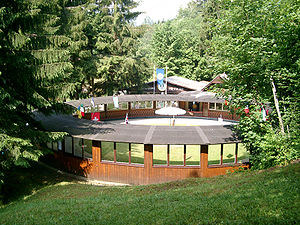
Tether car
Encyclopedia

Tether
A tether is a cord, fixture, or signal that anchors something movable to a reference point which may be fixed or moving. There are a number of applications for tethers: balloons, kites, tethered wind-energy conversion systems, anchors, tethered water-flow energy conversion systems, towing, animal...
ed to a central post. Unlike radio control
Radio control
Radio control is the use of radio signals to remotely control a device. The term is used frequently to refer to the control of model vehicles from a hand-held radio transmitter...
cars, the driver has no remote control over the model's speed or steering.
Basics
The cars are about 12-24 inches long, 3-4 inches wide, run on rubber tires 3-4 inches in diameter, have a cast metal body (usually magnesium and aluminum, but also fiberglass and wood bodies), and have robust gear drives. Engines are nitroNitromethane
Nitromethane is an organic compound with the chemical formula . It is the simplest organic nitro compound. It is a slightly viscous, highly polar liquid commonly used as a solvent in a variety of industrial applications such as in extractions, as a reaction medium, and as a cleaning solvent...
or methanol fueled, with displacements
Engine displacement
Engine displacement is the volume swept by all the pistons inside the cylinders of an internal combustion engine in a single movement from top dead centre to bottom dead centre . It is commonly specified in cubic centimeters , litres , or cubic inches...
from 0.09-0.61 cubic inches (1.5-10 cubic centimeters). Early engines (prior to 1960s) had spark ignition systems. Later engines use glow plug ignition. The cars are tethered to a central post hitch by a steel cable and run around a circular track of 19.9 meters in diameter.
History
Tether cars were developed beginning in the 1920s-30s and still are built, raced and collected today. First made by hobby craftsmen, tether cars were later produced in small numbers by commercial manufacturers such as Dooling Brothers (California), Dick McCoy (Duro-Matic Products), Garold Frymire (Fryco Engineering) BB Korn, and many others. Original examples of the early cars, made from 1930s-60s, are avidly collected today and command prices in the thousands of dollars.Today
Current racing activity in the U.S. is governed by the American Miniature Racing Car Association with three racetracks in NY, CA and IN. Contemporary cars run at speeds of up to 200+ miles per hour giving them the reputation as fastest model cars in the world. After push-starting the car the driver decides when to take the speed measurement. As soon as he presses a button the time for 8 laps, which equal to 500 meters, is accurately measured by 1/1000s.World Records
| Class | Date | Driver | Speed | |
|---|---|---|---|---|
| km/h | mph | |||
| WMCR I (1.5cm³) | December 9, 2006 |  Jan-Erik Falk Jan-Erik Falk |
268.697 | 166.961 |
| WMCR II (2.5cm³) | May 31, 2008 |  Priit Hoyer Priit Hoyer |
283.942 | 176.433 |
| WMCR III (3.5cm³) | August 13, 2004 |  Mart Sepp Mart Sepp |
293.375 | 182.295 |
| WMCR IV (5cm³) | May 31, 2008 |  Tonu Sepp Tonu Sepp |
309.139 | 192.090 |
| WMCR V (10cm³) | March 29, 2009 |  Gualtiero Picco Gualtiero Picco |
344.959 | 214.358 |
External links
- AMRCA - American Miniature Racing Car Association
- WMCR - World Organisation for Model Car Racing
- Tethercar.com
- Vintage Miniature Gas Powered Race Cars, private website covering the early history of tether cars
- GMBK - Gävle ModellBil Klubb
- Speed Modelcar, Most updated site with results and info Worldwide

